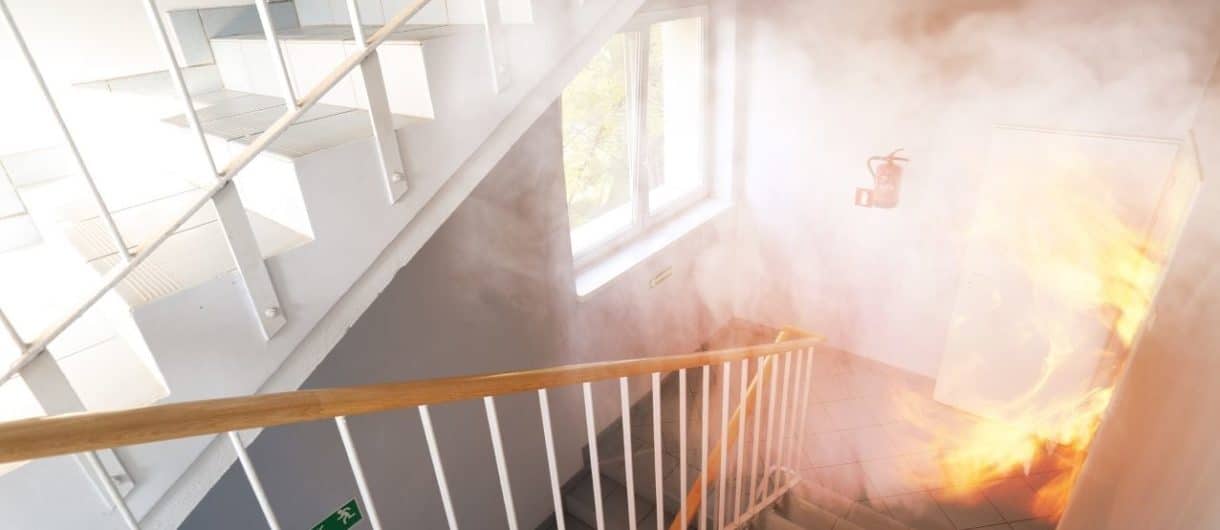
Smoke inhalation: its effects on health and how to avoid it
While flames are often thought to be the most dangerous part of a fire, smoke can be equally or even more harmful. In fact, smoke inhalation is the leading cause of death in fires: it was responsible for 57% of fatalities in such incidents in Spain in 2020 — far exceeding burns (29%), trauma (9%), or other injuries (1%), according to a recent report by Fundación Mapfre and the Professional Association of Fire Technicians.
In light of World Day for Safety and Health at Work, celebrated on April 28, we present this article to highlight key information about smoke inhalation and solutions to avoid or reduce its impact.
What will you learn in this article?
- What is smoke?
- What are the health effects of smoke inhalation?
- What are the symptoms of smoke inhalation?
- How can we avoid the effects of smoke intoxication?
- How can smoke curtains help prevent inhalation?
What is smoke?
Smoke is essentially hot vapor, but in a fire it usually comes with suspended particles and gases that may be irritating or suffocating, depending on the materials that have combusted. Many of these particles and gases can be toxic and pose significant risks to humans.
What are the health effects of smoke inhalation?
Fire smoke can cause various effects on people, such as thermal damage from high temperatures, irritation of external parts (like the eyes, skin, or nose) from toxic substances, and internal issues caused by inhalation intoxication.
Inhalation can significantly affect the human body, leading to respiratory issues (like bronchitis or asthma). It can also affect the cardiovascular system: some particles can deeply penetrate the lungs and reach the bloodstream, impacting other organs.
The severity of smoke intoxication depends on various factors such as whether the fire occurs in enclosed spaces, the victim’s medical history, the toxicity of the materials burned, and the length of exposure. Prolonged exposure can reduce available oxygen and cause fainting, seizures, asphyxiation, hypoxia, or even death.
What are the symptoms of smoke inhalation?
Smoke inhalation can cause breathing difficulties along with several other symptoms, including:
- Coughing
- Shortness of breath
- Blurred vision
- Headache
- Chest pain
- Hoarseness or noisy breathing
- Rapid heartbeat
- Nausea or vomiting
- Fatigue, confusion, and slower reflexes
- Feeling faint
Recognizing these signs is key to responding quickly and avoiding more serious consequences.
How can we avoid the effects of smoke intoxication?
When a fire breaks out, there are a number of actions we can take to avoid or reduce smoke inhalation. Among the most important tips are:
- Stay as low to the ground as possible, since smoke rises and consumes upper-level oxygen first.
- Wet a piece of clothing and cover your nose and mouth with it.
- Seek an open or ventilated space, or at least a window to access fresh air.
It is also essential to have a robust fire safety plan that includes smoke control systems such as detectors, smoke vents, tailored ventilation, and when needed, smoke curtains in complex areas.
How can smoke curtains help prevent inhalation?
Smoke curtains are textile screens that can help:
- Contain smoke particles and gases at the fire source, preventing their spread to other areas.
- Protect people in adjacent zones from inhaling potentially harmful vapors or gases.
- Improve visibility in nearby areas, facilitating safe evacuation.
As we can see, smoke curtains play a crucial role in preventing smoke intoxication. They are also highly adaptable and can be integrated into all kinds of buildings.
Need advice? Let’s talk.
Bibliography
- United Nations. (n.d.). World Day for Safety and Health at Work.
- Fundación Mapfre. (n.d.). Report on fire fatalities in Spain.